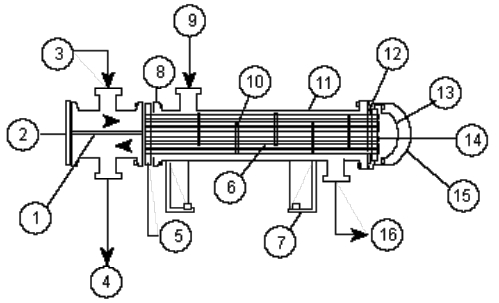A) carrying bar
B) moveable end cover
C) tube bundle sheet
D) plate stack
E) compression bolt
F) plate pack
G) hot fluid inlet
H) hot fluid outlet
I) fixed end plate
J) frame head
Correct Answer

verified
Correct Answer
verified
Multiple Choice
The heat exchanger that is designed to take the highest flow rates and largest temperature differences is:
A) u-tube
B) plate and frame
C) double-pipe
D) fixed heads, multipass
Correct Answer

verified
A
Correct Answer
verified
True/False
Inside a tube with streamline fluid flow temperatures are relatively constant.
Correct Answer

verified
False
Correct Answer
verified
True/False
Plate and frame heat exchangers are easy to clean and have high heat transfer coefficients.
Correct Answer

verified
Correct Answer
verified
True/False
A shell and tube heat exchanger can be used to heat and cool a substance.
Correct Answer

verified
Correct Answer
verified
Short Answer
List the parts of a floating head heat exchanger.

Correct Answer

verified
1) pass partition
2) channel cover & hea...View Answer
Show Answer
Correct Answer
verified
2) channel cover & hea...
View Answer
Multiple Choice
A layer of fluid that tends to adhere to the walls of a heat exchanger is referred to as:
A) laminar adhesion
B) static film
C) crystallization
D) slack
Correct Answer

verified
Correct Answer
verified
Essay
Draw a plate and frame heat exchanger. Identify each component! Show all flows!
Correct Answer

Answered by ExamLex AI
A plate and frame heat exchanger consist...View Answer
Show Answer
Correct Answer
Answered by ExamLex AI
View Answer
Multiple Choice
On a simple shell and tube heat exchanger a process technician would turn the device into a bomb if he closed which of the following valves first.
A) tube inlet valve #1- process fluid 125 F
B) tube outlet valve #2- process fluid 325 F
C) shell inlet valve #3- steam
D) shell outlet valve #4- steam
Correct Answer

verified
Correct Answer
verified
True/False
Plate and frame heat exchangers tend to foul easily because they have close clearances and low pressure drops across the plates.
Correct Answer

verified
Correct Answer
verified
Multiple Choice
Heat exchanger effectiveness is linked to all of the following except:
A) cross sectional area
B) ∆p
C) flow rate
D) differential temperature
E) electromagnetic wave intensity
Correct Answer

verified
E
Correct Answer
verified
Multiple Choice
Internal buildup on the surface area of a heat exchanger that results in a restriction is referred to as:
A) plugging
B) fouling
C) scale
D) purging
Correct Answer

verified
Correct Answer
verified
True/False
Turbulent flow allows molecules of fluid to mix and absorb heat energy better than laminar but it enhances the stationary film along the shell and tube walls.
Correct Answer

verified
Correct Answer
verified
Multiple Choice
A baffle that is designed to deflect high velocity fluids inside a heat exchanger.
A) longitudinal baffle
B) horizontal baffles
C) vertical baffles
D) impingement baffles
Correct Answer

verified
Correct Answer
verified
Multiple Choice
A term used to describe flow in a heat exchanger where tube-side flow and shell-side flow go in the same directions.
A) cross flow
B) horizontal flow
C) parallel flow
D) counter flow
Correct Answer

verified
Correct Answer
verified
Multiple Choice
A term used to describe flow in a heat exchanger where shell-side flow vertically crosses the horizontal tube flow.
A) cross flow
B) horizontal flow
C) parallel flow
D) counter flow
Correct Answer

verified
Correct Answer
verified
Short Answer
Draw a U-tube heat exchanger. Do not list parts. Show flows
Correct Answer

Answered by ExamLex AI
As an AI text-based model, I'm unable to...View Answer
Show Answer
Correct Answer
Answered by ExamLex AI
View Answer
Multiple Choice
A type of heat exchanger that uses a tubular bundle to heat and flash a liquid in an over-sized shell with a vapor disengaging cavity.
A) kettle
B) thermosiphon
C) pot belly reboiler
D) a & c
Correct Answer

verified
Correct Answer
verified
True/False
The tub head on a floating head heat exchanger is firmly attached to the tube sheet.
Correct Answer

verified
Correct Answer
verified
True/False
Hairpin heat exchangers are relatively easy to clean and install.
Correct Answer

verified
Correct Answer
verified
Showing 1 - 20 of 42
Related Exams